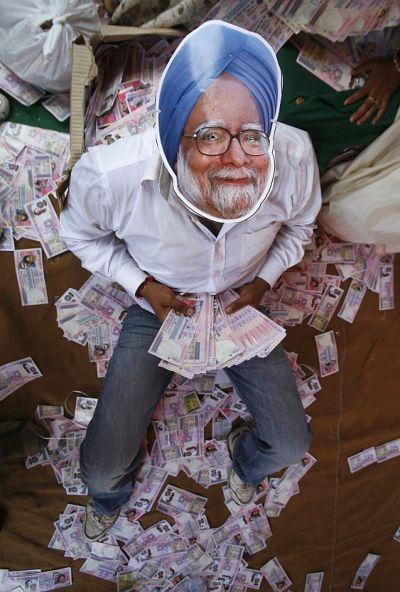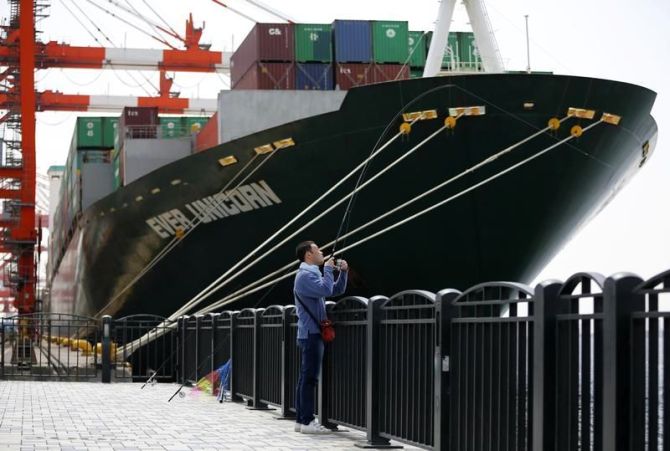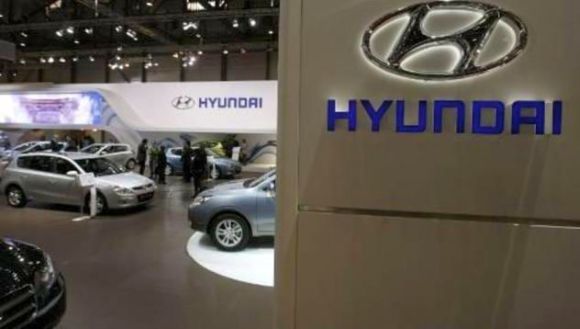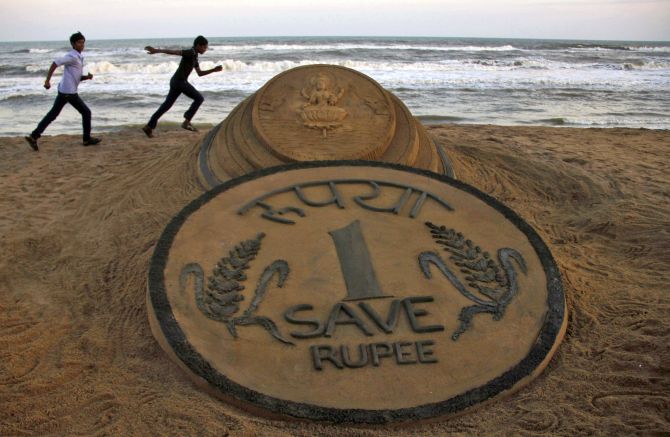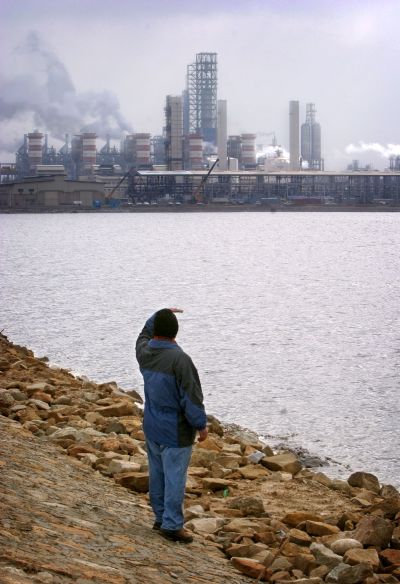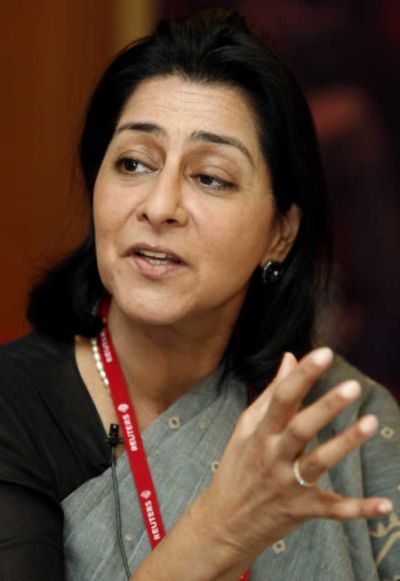 | « Back to article | Print this article |
Mr PM you are wrong; cheap rupee will not boost exports
The upside of the rupee's slump is an export boom that sets the economy straight, right? Wrong.
Prime Minister Manmohan Singh echoed classical economic theory when he told parliament last month that the plunging rupee, which has lost 18 per cent against the dollar since selling pressure picked up in May, would spur exports and discourage imports.
Some industries are bracing for a depreciation bonanza and exports are already climbing. They rose at a double-digit pace over a year earlier in the last two months, but for a hosts of reasons, Asia's third-largest economy is unlikely to see the sort of sustained export-led revival that nursed the Tiger economies to the east back to health after the 1997 crisis decimated their currencies.
A multitude of stumbling blocks mean that exporters, from farmers to factory owners, are ill-placed to reap the benefits of the rupee's slide: bad news for policymakers and investors looking for a silver lining in India's worst economic slump in 20 years.
These hurdles range from erratic taxes throttling special export zones to a cash crunch and clogged ports.
Click NEXT to read more…
Mr PM you are wrong; cheap rupee will not boost exports
"Notwithstanding the rupee depreciation, relatively high inflation and infrastructural deficits continue to raise the costs of production and constrain the ramping-up of exports," said Aditi Nayar, an economist at the rating agency ICRA, an arm of the Credit Rating Agency Moody's Investors Service.
"With only a moderate improvement in demand conditions in key destinations such as the U.S. and Europe over the last six months, foreign buyers will attempt to squeeze the margins being earned by Indian exporters," she said.
To make things worse, a dependence on imports for 80 per cent of India's oil needs plus a growing chunk of the coal keeping the lights on will limit the cheaper rupee's ability to reduce the world's third-largest current account deficit.
Imports weigh heavily on Indian exporters too.
Take the country's two main exports, petrochemical products and jewellery, which together accounted for nearly a quarter of India's $450 billion overseas sales last year. They are mostly made with oil and gold, India's top two imports, which also cost more now because of the rupee's diminished purchasing power.
Click NEXT to read more…
Mr PM you are wrong; cheap rupee will not boost exports
Manufacturing suffers for the same reason: parts used in Indian car plants and factories assembling electronics largely come from overseas, pressuring margins when the rupee drops.
Hyundai Motor India Ltd, the country's leading car exporter, is bracing for some price pain. Its finance and corporate affairs director, R. Sethuraman, told Reuters the rupee would not help exports for long, if at all.
"Rupee depreciation has a limited advantage, and that too only in the short term. Continuous depreciation will have a reverse impact on pricing in the export market and an adverse impact on input costs," he said.
India's Motor City of Chennai is an example of the stumbling blocks preventing exporters from exploiting rupee weakness. The city is plagued by power cuts, so manufacturers rely on expensive onsite generation.
Chennai port is so congested that trucks often spend three days driving just 30 km from the factory district to the port. A long-mooted expressway is delayed.
Click NEXT to read more…
Mr PM you are wrong; cheap rupee will not boost exports
Chennai's story is repeated across India. The boom during the last decade was not matched by increased infrastructure, so traders struggle to get their products to cargo ships on time. Blackouts raise everybody's costs.
After authorities shut down mines two years ago largely to clamp down on illegal mining, iron ore exports fell from $6 billion to almost nothing. India's agricultural exports, swelled by a bumper monsoon harvest, are limited by a global glut, quality issues and government price restrictions.
"We are sitting on a mountain of sugar. We can export 4-5 million tonnes, but we are struggling to sign deals for a few thousand tonnes," said trader Kamal Jain. "There has been a drop in currencies of other countries as well, like Brazil."
Little Italy, Very Little
Perhaps most damaging is the government's thirst for revenue. The need for income to meet tough fiscal targets is choking Special Economic Zones (SEZs) set up in 2005 to copy the success of China's economic rise.
Orient Craft thought big when it bought 400 acres of farmland in an up-and-coming industrial town close to New Delhi airport and a railway link to the west coast. The vision was to make it north India's biggest apparel export zone, modelled on Italy's traditional textile capital, Prato.
Click NEXT to read more…
Mr PM you are wrong; cheap rupee will not boost exports
As the global economy boomed in 2007, the aim to attract a billion dollars of investment and create 20,000 jobs in a "Fashion Village", seemed reasonable. Dupont was interested, Commercial Director A.K. Jain said.
"We started the Fashion Village apparel SEZ thinking it would become a mini-Italy," said Jain.
Orient Craft had the land designated as an SEZ, built a 13-km boundary wall and a warehouse, laid concrete roads and planted trees. In all, it invested more than $30 million.
What happened next helps illustrate the missteps of a government that businesses say translates into lost opportunity and wasted capital.
Backed by a 10-year tax holiday, exports from the zones soared 13 times over six years to reach $66 billion in 2010/11, about 17 percent of India's $384 billion of exports that year.
But in 2011, the government slapped an 18.5 per cent Minimum Acceptance Tax (MAT) on future profits - in effect, killing the goose that laid the golden eggs, exporters say.
Click NEXT to read more…
Mr PM you are wrong; cheap rupee will not boost exports
The rapid exports growth from SEZs slowed to a crawl. New investment tailed off, data from polling group Ipsos shows.
Orient Craft threw in the towel two weeks ago, surrendering its SEZ license. It was not alone: just 173 of 576 approved SEZs are operating today. Close to 60 developers, including Reliance Industries, a major exporter, have given up licenses.
In February, an Ipsos survey of 400 companies operating in SEZs found 62 per cent of respondents had suspended plans to invest further in the zones, while 75 per cent thought the tax hurt India's reputation.
Jain said the zones were now economically unviable for manufacturers, strong words from someone who is deputy chairman of an industry chamber promoting exports from SEZs.
"No promoter will ever think or advise the next generation to invest in SEZs or any such project for many years," Jain said.
Click NEXT to read more…
Mr PM you are wrong; cheap rupee will not boost exports
Export Priority?
Exporters that do not depend so much on imports are benefitting from the weak rupee. That includes Orient Craft; its 15 factories in the Delhi area have the fullest order book in years.
Textiles and pharmaceuticals, which exported $33 billion and $15 billion respectively in 2011/12, are set for a boost.
Service industries, including IT outsourcing, which account for around one-third of India's exports, might also experience gains. Reflecting that, India's IT stock index rose 36 per cent from the start of May through Friday.
Some players though, including IT solutions company Mindtree Ltd, see problems ahead.
"Our largest cost is people cost, and with the ... rupee the way it's going, inflation will go out of control and obviously salary costs will also go out of control," said Rostow Ravanan, Mindtree's chief financial officer.
For others, there is a sense of opportunity lost. In raising rates to try to stem the currency rout, the central bank made it harder for companies to expand quickly to meet new orders.
Click NEXT to read more…
Mr PM you are wrong; cheap rupee will not boost exports
To help, the finance ministry last month increased a subsidy on interest rates on loans for exporters, but Naina Lal Kidwai, president of the Federation of Indian Chambers of Commerce and Industry, said high taxes are the main export drag.
Some relief may be coming there, too. The trade ministry is mulling a lower tax on iron ore exports. And the government's top revenue official said India will soon clarify rules to help resolve dozens of litigation cases that hit IT multinationals in the past year as taxmen scrambled to meet the government's fiscal deficit target. IT companies say these tax battles had weighed on their growth.
"Priority sector lending" - cheap interest rates - are also being discussed for exporters, a senior official at the financial ministry said.
That, exporters say, would help more than the rupee drop.
"It is possible for (goods) exports to touch $350 billion this year, surpassing the government estimate by about $25 billion if the government provides sufficient credit and marketing support," said Rafeeq Ahmed, head of an exporters' lobby group.
(Additional reporting by Rajesh Kumar Singh, Krishna Das and Matthias Williams in New Delhi, by Rajendra Jadhav and Siddesh Mayenkar in Mumbai, by Harichandan Arakali in Bangalore and by Anupama Chandrasekaran in Chennai)

© Copyright 2025 Reuters Limited. All rights reserved. Republication or redistribution of Reuters content, including by framing or similar means, is expressly prohibited without the prior written consent of Reuters. Reuters shall not be liable for any errors or delays in the content, or for any actions taken in reliance thereon.
